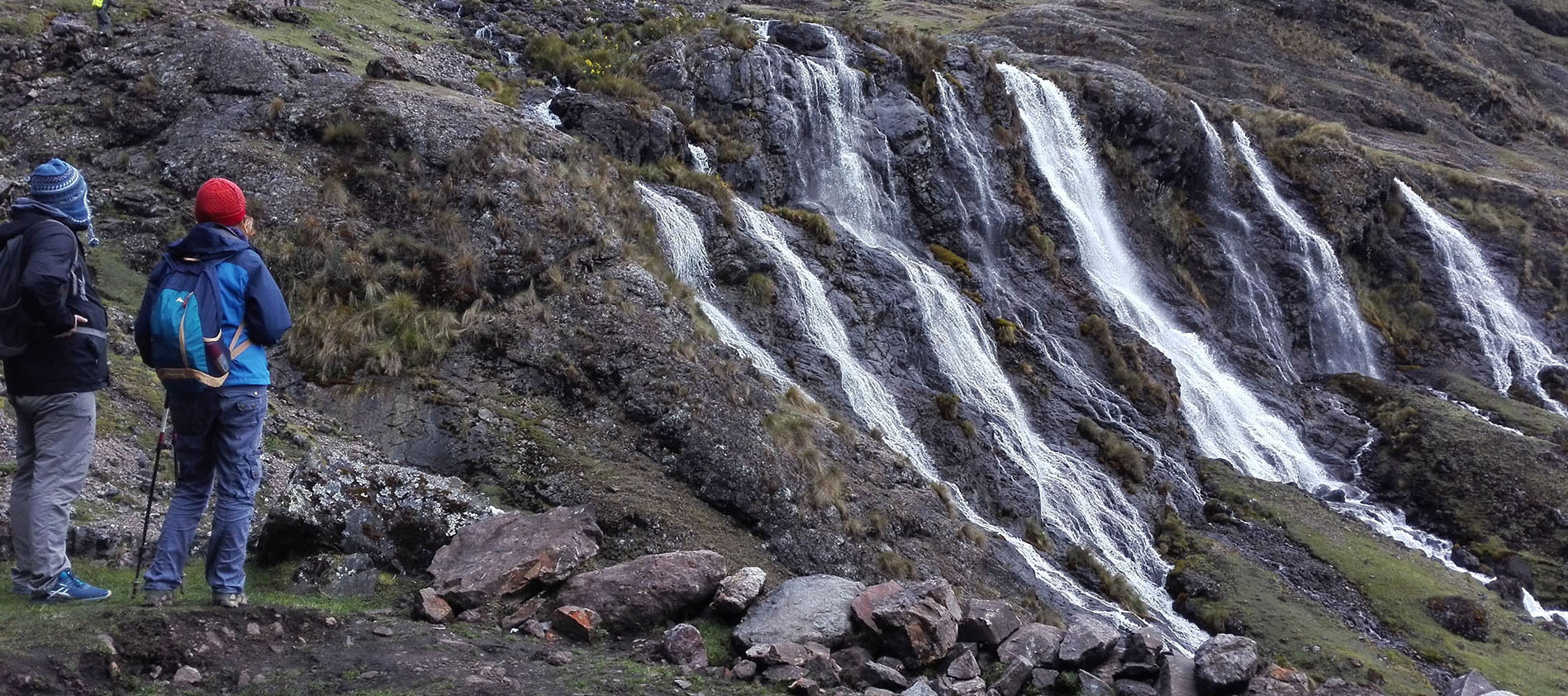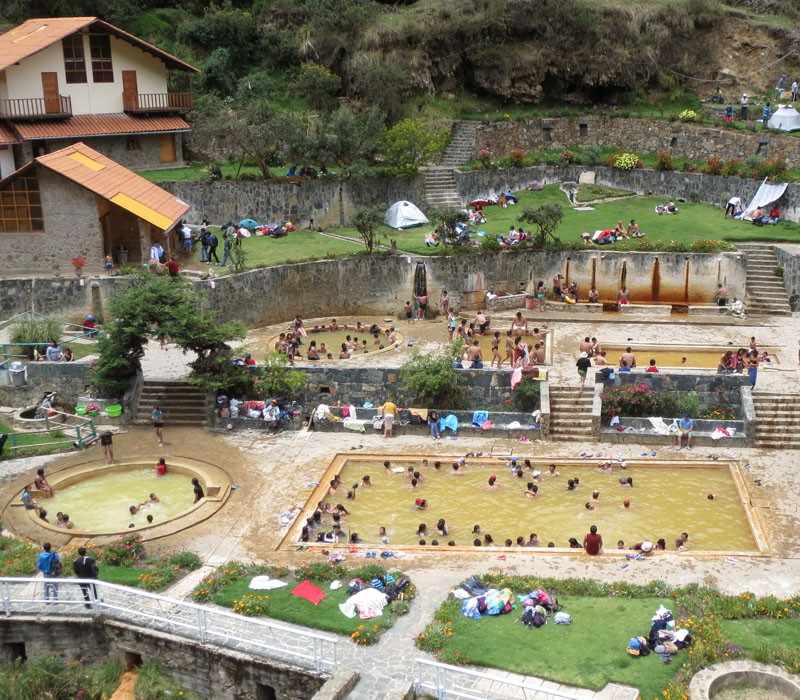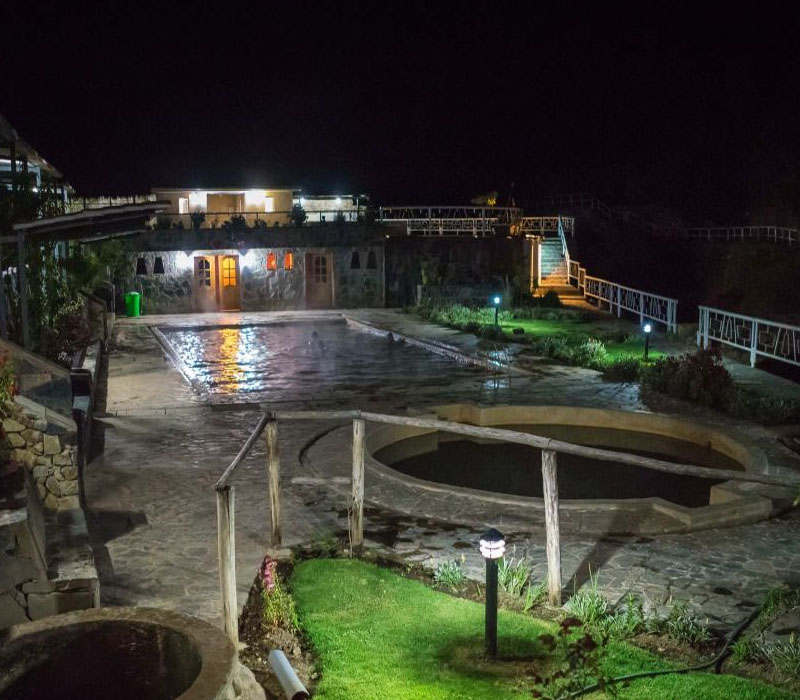
Day 1: Cusco – Famous Thermal Baths – Kiswarani Waterfall Campsite
We will pick you from your hotel at 5 a.m. to begin the famous Lares Trek. We can pick you from any hotel, condo, or apartment, if it is located in the cities of Cusco, Urubamba, Huaran or Pisaq. It will be a three hour drive along the beautiful landscape of the Sacred Valley and through the Andes, until we arrive at the Lares Hot Springs site, where you will have your first breakfast accompanied by amazing views of the Andes Mountains. Then, you will enjoy the hot springs, which are divided into various pools ranging from freezing cold to boiling. They are all composed of pure volcanic water, which is medicinal in nature and considered to be good for your bones, stress, muscles and headaches. After soaking in the baths for a while, you will drive 20 minutes to the trail head, Punta Carretera at 3,300 m/ 10,827 ft above sea level. It is here that you will meet up with your horses and horsemen. You will give your duffel bags to the horsemen to be transported to the campsite. Following, you will begin your expedition to Machu Picchu. To start, it will be a two hour, gradual uphill hike, until we reach our lunch spot at the first village, called Kiswarani. This section of the hike is considered the potato valley sector, where people farm many varieties of organic potatoes. Your guide will also point out some indigenous, medicinal plants growing along the way. Then, we will arrive at our lunch spot, where you will enjoy your first delicious meal prepared by our trekking chef.
After lunch, our horsemen (llameros) will do a ceremony with llamas showcasing these beautiful animals. Llamas were considered sacred to the incas and fundamental to their economy. Our llameros will introduce you to these animals and discuss their importance and why owning one was a sign of priveledge. Today they are disappearing, constantly breaded with smaller animals. We hope to continue the tradition of the incas and give some llamas work. This is our way of supporting the community that helps protect them. Llamas are friendly and strong animals and are a nice companion to walk with. Just don’t get too close, they might try to give you a kiss.
You will also have time to explore the village and visit some local homes, where you will learn about the lifestyle and ancient traditions of the local people. If there is time, we will visit the school where the kids still speak Quecha, their native language. If you’d like, you may bring some toys, notebooks or any type of school supplies to share. Perhaps you may even teach them a few English words. It will be another two hour, gradual, uphill hike until we arrive at the campsite, where you will be welcomed by our trekking staff, who will have your tents set up. We’ll enjoy some hot drinks, as the sky darkens and the stars start appearing. Our guide will lead you to a specific location to enjoy the magnificent view of the sky, and we’ll learn about the Incan constellations, which were studied at great length by the Incan people, to learn about the seasons and to assist them in their planting. Your guide will use our telescope to spot the famous Inca constellations, such as the Southern Cross (Cruz del Sur) cosmic constellation, Orion and many others. We are the only company that provides telescopes for the Lares trek. Finally, you will enjoy a lovely dinner prepared on site. If you want to keep star-gazing, you may stay up for a while longer or, if you’d rather, you can turn in to your tent.
Day 2: Quiswarani – Condor Pass – Cancha Cancha Village
Today you will be woken up around 5 a.m., with our service of hot drinks. You will have amazing views of the colorful lake and the valley of Kiswarani. The local people will already be up and about, taking their llamas and alpacas out to graze. Breakfast will be served as soon as you finish packing your gear. Then we’ll fill up our water bottles, organize snacks and you will begin the most memorable day of your expedition to Machu Picchu. It will be a three or four hour climb to get to the summit of the mountain. This pass is called Pachacute, or Condor Pass. We’ll zigzag our way up to compensate for the steep uphill. The views of the area are stunning. You will see lakes, waterfalls, llamas, and alpacas. We will have an emergency horse to ride in case you are tired. Once you arrive at the Condor Pass you will be above the clouds, above the mountain peaks and the surrounding 360 degree views are astounding. In front of you will be the majestic mountain of Pitusiray, which is at 5,700 m/ 18,700 ft high, and the Condor pass is at 4,680 m/ 15,354 ft high. Afterwards, we will enjoy the hot drink service that your porters will carry with them. We will take advantage of some phenomenal photo opportunities, and start our descent.
You will begin the one hour, downhill, descent towards El Mirador (Vista Point), where you will enjoy lunch. There will perhaps be some llamas grazing nearby. After lunch, you will hike the last three hours downhill, with fantastic views of many lakes, llamas and alpacas, before arriving at your campsite, the village of Cancha Cancha, which is the only village that does not have modern technology. Cancha Cancha is a village (3,750 m/ 12,303 ft) where people still practice real traditions of the Incas. In this Incan village, 85 percent of the houses are still composed of original, ancient construction, made of stone, with grass-thatched roofs. Unlike any other village in the Lares Valley, this village where has no electricity or cars. Here, you will not only enjoy the wilderness, but your porters will also set up your tents. You will have some time to meet with the local children. We provide them with food and school supplies, so we invite our travelers to share this support in the education and the health of this native village. You can join us and bring anything you would like to supplement the lives of these Quechuan-speaking children. Following, your guide will take you to one of the local family’s houses, where you will learn about the lifestyle of the locals. You can see how they raise their guinea pigs, and you will learn about the traditional, hand-woven textiles, made of llama and alpaca wool. This is the best day of your hike. In the evening you will enjoy hot drinks and dinner.
Day 3: Cancha Cancha – Huaran – Maras Salt Mine – Ollantaytambo – Aguas Calientes
Our porters will wake you up with a hot drink and you will have some time to pack your bags and enjoy breakfast. After breakfast, you’ll have time to explore the village and visit the local elementary school, where the ancient Inca language, Quechua, is still taught. Once you are ready, you’ll begin the last leg of your Lares trek. It will be four hours of walking downhill, along this lovely path, where you will pass by more llamas and alpacas. We’ll pass by farms where they cultivate potatoes, fava beans, and many other traditional tubers, in the traditional Incan style. This is a great opportunity to learn about Peruvian agriculture because people still farm by hand with traditional, Inca farming tools. Now, we will start to descend to the warmer area, The Sacred Valley. You will begin to feel the micro-climate changes and start seeing crops that are different from in the high mountains. Around the Sacred Valley people farm corn, quinoa, kiwi, peaches, avocados and other types of fruits. Of course, this area has a lot of Incan history. You will end the tour at the little village of Huaran, in the Sacred Valley, at 2,700m / 8,858 ft where you will say goodbye to your horses, horsemen, chef and porters, as they will be going back to their homes.
From Huaran, we will catch a van and make the short drive into the valley to visit the Salineras salt pans, in the town of Maras. Here, at 11,000 feet above sea level, a salt water spring gushes forth and spills down the side of the mountain. Over 3,000 small evaporation chambers have been created and look as if they are tumbling down the mountainside. These have been in use since pre-Incan times. The salt is said to have healing properties because it is loaded with natural minerals, some of it even comes out pink. Local families each own one of these pans, and make their living supplying salt to the towns around the area. There is a small shop on site, if you care to take some salt home with you.
After visiting Salineras, we will climb aboard the van for a 45 minute drive, that skirts along the Sacred Valley to Ollantaytambo. Ollantaytambo is the only living, intact Inca village. It still has many Inca water channels, houses and walls. Your guide will take you around to view this small town until it is time for dinner, which will be at a local restaurant. We’ll then catch the 7 p.m. train for Aguas Calientes, the town below Machu Picchu (train times may vary, depending on availability). Upon your arrival to Aguas Calientes, you will check-in to your hotel and relax.
Day 4: Machu Picchu – Ollantaytambo – Cusco
Day four is the most magical day because you will finally experience Machu Picchu. You will wake up early to catch one of the first buses (around 5:30 a.m.), for the 30 minute ride up to Machu Picchu. You will see the Sunrise over the ruins. Your guide will take you for an informative two hour tour. Afterwards, you will have time to explore on your own and hike Huayna Picchu if you choose to (this is a separate entrance ticket and costs $35 per person). In the afternoon, you’ll catch a two hour train back to Ollantaytambo, followed by a bus back to Cusco, where we will transfer you to your hotel.
Note:
If you want to stay an extra night in Aguas Calientes, please let us know in advance. We can adjust your train tickets and arrange for a hotel, if you would like us to help.
Rangers do not allow people to carry large backpacks inside Machu Picchu. Only day packs are allowed inside.
No trekking poles are allowed in Machu Picchu.
Snacks and water are allowed, but they must be inside your backpack.
Included
Professional Guides
All of our guides studied English and tourism at Cusco National University. They all grew up in this region and have a true passion to teach others about their heritage. They are fun yet professional, and will ensure you are safe and happy.
Briefing
The night before your trek, you will come to our office at 6:30PM for your briefing with your trekking guide. You will receive your duffel bag for your personal items which must include your sleeping bag and air matt (ours weigh 2.5 kg and 1 kg respectively). These bags will be carried by your porters and available only at your campsite (morning and evening). Any items you need while hiking should be in your daypack.
Porters & Horsemen
We include a personal porter, who is responsible for carrying your duffel bag containing your personal items. There is no additional fee for this. We will give you your duffel bag at your briefing the night before, to be filled with the things you will need for the next night and day. You will not have access to your duffel bag until your arrive at your evening campsite.
Emergency Horse
All of our alternative treks include an extra horse for our clients to use if they need a break from trekking.
Hotel
The trek will include two nights of camping, close to local villages, and one night in a hotel in Aguas Calientes, the town below Machu Picchu. We include a 3 star hotel, typically at Inti Punku (or similar), if available. Your booked hotel will be listed on your confirmed invoice. Upgrades are always possible.
Transportation
All your transportation is included in this trek. You will be picked up directly from your hotel around 4:30 a.m. (unless you are staying in Ollantaytambo, before the trek) and brought to the trailhead to begin your trek. Hiking will end on day three and you will head to Ollantaytambo, once your hike is over, and train to Aguas Calientes, where you will spend the evening in a hotel. This train, as well as your train back from Aguas Calientes to Ollantaytambo, is Expedition class. Your trip leaving Aguas Calientes can be upgraded on your way home to the Vistadome train, for $75 per person. Once you arrive to the train station, you will be brought back to your hotel in Cusco. Your round-trip bus ticket from Aguas Calientes to Machu Picchu is also included.
Equipment
Alpaca Expeditions has the best equipment. We use Eureka Timberline 4 person tents that are shared by only two people. You will have a spacious dining tent to enjoy your meals in.
Food
The Alpaca Expeditions chefs cook delicious meals that many previous trekkers have raved about. We honor all food restrictions. Be sure to remind your tour guide of any food restrictions at the beginning of your trek. Food is typically served family-style. You will enjoy breakfast, lunch and dinner each day of the trek, along with a happy hour of tea and snacks. You will also be provided a snack each morning, for you to enjoy along the hike. Your last meal with your chef will be after breakfast on day four. Lunch the last day is not included. You will enjoy breakfast, lunch and dinner each day of the trek along with a happy hour of some tea and snacks. You will also be provided a snack each morning for you to bring with you and enjoy along the hike. Lunch the last day is not included.
Water
Beginning from your first lunch until your last breakfast, Alpaca Expeditions will supply all the water needed. This water will be boiled, filtered and then cooled, before distributing. You must supply your own water bottles or camel back. We recommend carrying about 3L worth. We will refill our waters at each meal.
First Aid
Every Alpaca Expeditions guide has received training in first aid from a physician. We conduct mandatory training sessions every February, which every single Alpaca tour guide must attend. Your tour guide will always have a first-aid kit for basic medical problems (traveler’s diarrhea, cuts, scrapes, etc.) and oxygen. We will get you off the trail as quickly and comfortably as possible, if needed, and ensure you get directly to a clinic for treatment.
Extras
We believe it’s the attention to small details that separates us from other tour companies. Every trekker receives a small pillow to sleep with, a foam mat for insulation, a day pack cover to protect their things while hiking and a rain poncho. We will work hard to create your best vacation.
Satellite Phones
Our top priority will always be the safety of our clients and our team. While we are prepared and all our guides are trained for most of the issues clients have on the mountain, being a phone call away from any doctor, hospital or friend helps everyone feel assured that they are safe. Radios, which all our guides have, are limited in how far they can reach, so Alpaca Expeditions has added Satellite Phones to every trek. Every guide will have a fully charged phone that can be used anywhere on the mountain to connect us anywhere in the world. And they can be used by our clients for non-emergencies as well. While they are not cheap to use, they are available just in case you need to check in on the puppy you left at home with grandma.
Not Included
Rentals
Every trekker needs a sleeping bag, when camping. Inflatable air mattresses and walking sticks (with rubber tips) are optional, but encouraged. If you don’t want to bring any of the above, they are all available for rent:
Sleeping Bag: $20
Inflatable Air Mattress: $15
Walking Sticks (Pair): $15
Huayna Picchu
Huayna Picchu is the mountain that stands next to Machu Picchu. It is a 45 minute hike to the top. Going back down is quite steep, if you are scared of heights. This is done after your tour of Machu Picchu. The cost is $35. Arrangements need to be made at least one month in advance, due to popularity. Please understand that weather is out of our control.



